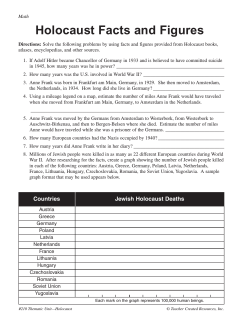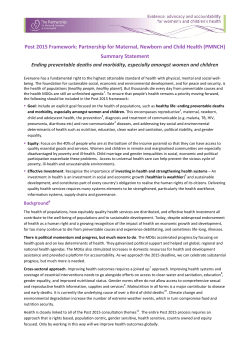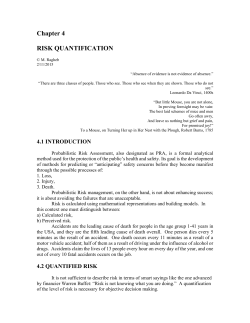
ANALYSIS
ANALYSIS Childhood deaths: how to respond and what we can learn New procedures for reviewing child deaths should improve support for families and enable action to reduce mortality. Peter Sidebotham and Gale Pearson explain how they work No of deaths Although child mortality has fallen signifi‑ cantly over the past century,1 there is still scope for improvement. In 2005, over 3200 infants (5 per 1000 live births) and 1200 chil‑ dren under the age of 15 (14 per 100 000 population) died in England and Wales,2 with large discrepancies in mortality between different areas and between different socio‑ economic and cultural groups. Many of these deaths are preventable—whether they are from external causes or from natural condi‑ tions that are not normally fatal. Several stud‑ ies have concluded that as many as 29% of child deaths may be preventable or contrib‑ uted to by potentially avoidable factors.1 3 4 It is important, therefore, to examine the causes of child death and learn from them. The highest risk of death is in infancy, par‑ ticularly in the first month of life. Risk tails off to low levels in middle childhood before rising again in adolescence. The causes of death also vary with age (fig 1). Perinatal and congenital conditions predominate in the first month. However, in later infancy and middle childhood years, most deaths are 2500 External causes Not classified Infections Cancers Organ systems Congenital/perinatal 2000 1500 1000 government brought in new legislation and guidance through the Children Act 2004 and revised multiagency guidance, Working Together to Safeguard Children.4 This guidance places a responsibility on local safeguarding children boards and their constituent agencies (health, education, social services, police, and other services for children and families) to put in place procedures both to respond rapidly to individual unexpected childhood deaths and to review all childhood deaths systemati‑ cally. Below, we outline these two processes and the implications for health professionals. Research in this area is extremely limited, and the new processes are largely based on perceived good practice rather than a robust evidence base. Responding to unexpected child deaths One of the key components of the new govern‑ ment guidance is a coordinated multiagency approach to investigating the unexpected death of a child and supporting the bereaved family.5 6 An unexpected death is defined as one that was not considered a serious Sudden unexpected death of an infant or child Immediate response: Transfer to hospital, emergency department care, initial history and examination, immediate investigations, multiagency liaison Early response: Multiagency information sharing and planning meetings, joint home visit, detailed history, scene review, autopsy, ongoing family support 500 ar s ye ar s 9 Age Fig 1 | Causes of death in childhood in England and Wales, 20041 574 Later response: Further investigations and inquiries, final case discussion and report, coroner’s inquest, feedback to family -1 15 4 ye ar s 9 ye -1 10 ar s 5- ye r 4 1- 1 m on th -1 m on ye a th 0 <1 from medical causes, although up to a quar‑ ter are related to external causes or remain unexplained, including deaths from sudden infant death syndrome. The pattern changes in adolescence, with half of deaths being from external causes. Whatever the underlying causes, each death is a tragedy for the affected family and the wider community. After the death of a child, the experience of families varies enor‑ mously, and for many, professional responses to their bereavement compound rather than help their trauma.5‑7 In a study of bereaved families in England and Wales in the 1990s, Dent et al found that although many were satisfied with the care given by the emer‑ gency services, some thought that the police could have been more sympathetic and less accusing; many were not given appropriate information or offered support; and more than half were not offered follow-up care by the hospital.3 In response to some of these issues and in line with a broad emphasis on safeguarding children and promoting their welfare, the Identifying contributory factors Establishing cause of death (coroner) Support for family Fig 2 | Responding to an unexpected child death BMJ | 7 MARCH 2009 | Volume 338 ANALYSIS Box 1 | Core components of response to unexpected child deaths Information gathering Including a thorough medical history, examination of the child, investigation of the circumstances of the death (including where appropriate, a visit to the home or scene of death), and a structured postmortem examination with appropriate ancillary investigations Collation and evaluation of the information gained Through ongoing liaison between the professionals involved and a final structured case discussion The bridgeman art library/getty Ongoing support to the family Includes providing them with information and linking into sources of bereavement support possibility 24 hours before the death itself Experience in the southwest of England has or any unexpected collapse or precipitating shown that, with appropriate support, local event that led to the death.7 It would not nor‑ teams can achieve a rapid response to an unex‑ mally include the death of an infant or child pected infant death in at least 90% of cases (P in a hospital or of a child Fleming et al, unpub‑ with a known life limiting lished results). Our condition. Response to experience in talking an unexpected death has with bereaved families three primary purposes: suggests that these proc‑ to establish, in conjunc‑ esses are well received tion with the coroner, a by parents and that cause of death; to identify they can improve the any contributory factors; ascertainment of causes and to provide ongoing of death and potential support to the family (fig contributory factors. 2). Central to this is a thorough and systematic Child death review investigation that remains processes sensitive to the needs of The principles of multi‑ the bereaved family. Cer‑ agency reviews of child tain core components of deaths to learn lessons the process require the and safeguard chil‑ input of health profession‑ Death Taking a Child engraved by Hans dren’s welfare is long Lutzelberger, c 1526-8 als (box 1).8 established in the UK. Many areas of the UK Serious case reviews are exploring team based approaches to these (part 8 reviews) are implemented when responses, drawing on the relevant skills of abuse or neglect is thought to be a factor in primary and secondary medical and nursing the death or serious injury of a child.9 10 In staff. Experience suggests that each unexpected addition, there is a long history of more health death in infancy requires about 16-20 hours’ oriented approaches, most notably the con‑ input from the paediatric team, mostly con‑ fidential inquiries into stillbirths and deaths centrated in the first 48 hours, and a primary in infancy.7 Experience in the United States, care trust with a population of 500 000 would where teams to review child deaths have been experience 10-15 unexpected deaths a year, of in place since the 1970s,10 11 has shown appre‑ which at least half would require a full multia‑ ciable benefits. Other countries have also gency response, and the remainder a less inten‑ reported benefits (box 2 on bmj.com). sive response—for example, where the cause of In their review of the published literature on death is apparent at presentation. child death for the Scottish Executive, Axford Most parts of the country have clear pro‑ and Bullock concluded that “there is some tocols for responding to sudden unexpected evidence of the impact of reviews on immedideath in infancy, and many places are ate and intermediate outcomes—insofar as they exploring how to extend these processes to shape policy, guidance, training and, to some deaths of older children in the community. extent, practice—but benefits for ultimate BMJ | 7 mARCh 2009 | Volume 338 Experience suggests that each unexpected death in infancy requires about 16-20 hours’ input from the paediatric team, mostly concentrated in the first 48 hours outcomes, measured in terms of children’s well-being, are less apparent.”11 More robust evaluation of the impact of these review proc‑ esses on outcomes for children is needed. Local lessons We have led two recent studies of the processes for reviewing child deaths in the UK.16 17 Box 3 summarises some of the key outcomes from these studies. The reviews are carried out by child death overview panels that meet 4-12 times a year for around two to three hours. Panels typically have a core membership drawn from key agencies and include other members with specific exper‑ tise on particular cases as required—for exam‑ ple, a transport police officer for deaths from road traffic collisions or a cardiologist when looking at deaths from congenital heart defects. Although it is helpful to have panel members with local knowledge and expe‑ rience, some independence is needed to enable a more objective review. This can be achieved through an independent chair who is not directly involved in providing services to children, through incorporating lay mem‑ bership on the panel, or through robust lines of accountability and reporting to the local safeguarding children board. For each case reviewed, leads in each agency need to review the information known about the child and family and prepare a report. Panels work best when the members are provided with clear summarised and col‑ lated information before the meeting, rather than trying to assimilate information from case files at the panel meeting. Participants in the studies raised several concerns relating to confidentiality and information sharing. Sharing personal and sensitive information is important to identifying matters affecting the safety and welfare of children. It there‑ fore serves the public interest. However, such 575 ANALYSIS Box 3 | Lessons learnt from UK studies of child death reviews16 17 Identifying modifiable factors One study identified avoidable factors in 26% of cases reviewed and potentially avoidable factors in a further 43%.17 Factors related to the child, parental care, wider family and environmental factors, and service need and provision. They included: •Recognition of recurrent injuries in teenagers who had unnatural deaths (present in 8/14) •Missed hospital or primary care appointments in teenagers at risk •Delayed vaccination in infants born prematurely or with underlying congenital illness •Failure of primary care practitioners and emergency departments to recognise severe acute illness •“Dangerous” co-sleeping (eg, after drinking alcohol or smoking) leading to sudden infant death16 •Recognition of dangers on zigzag areas at pedestrian crossings (a factor in 12/19 child pedestrian deaths) Identifying good practice Examples of high quality care in the studies included: •Appropriate recognition and referral of severe illness in primary care •High quality multidisciplinary palliative care for children with life limiting illness, chronic disease, or disability •Good resuscitation technique among paramedics and in emergency departments Responding to children with life limiting illness 77% of children who died had existing illnesses or complex needs. Reviews provide an opportunity to examine the children’s care and improve services for future children and their families Focus on outcomes Several important changes arose from the reviews: •Public awareness campaign on holiday safety developed in response to the death of a child in a swimming pool abroad •Revised policies for servicing gas appliances in social housing after the death of a child from carbon monoxide poisoning •Improved services in bereavement support and information sharing with primary care information should be treated with respect, anonymised where possible, and families informed of the process. Implications for health professionals In Working Together to Safeguard Children, the government set a target date of 1 April 2008 for implementation of child death review processes. Several months on, many local boards have developed and implemented both rapid response and child death review procedures. Last year, the government announced it would give £52m over the next three years to support these processes. Supporting materials, including training materials are avail‑ able on the Every Child Matters website (www.everychildmatters.gov.uk/socialcare/ safeguarding/childdeathreview/). Given the paucity of current research in this area, the introduction of national systems provides a unique opportunity for national collation of data. Both systems must be rigorously evalu‑ ated so that further lessons can be learnt and procedures improved. Our experience in talking to health profes‑ sionals around the country is that there is a 576 mixture of apprehension and enthusiasm about these new processes. The apprehensions seem to focus largely around the resources required when services are already stretched. This concern is often compounded by a lack of clarity over what is expected of health pro‑ fessionals and a fear that they will be called to step outside their areas of expertise. That was never the intention. Rather, by working as a team, professionals should be able to draw on the complementary skills and knowledge of other members and so better support families and learn from children’s deaths. The enthu‑ siasm comes in when professionals begin to recognise the potential of these processes to improve investigations, to improve the experi‑ ence of bereaved families, and to take steps to reduce child mortality and improve the health and wellbeing of our children. Peter Sidebotham senior lecturer in child health, University of Warwick, Health Sciences Research Institute, University of Warwick, Coventry CV4 7AL Gale Pearson consultant paediatric intensivist, Birmingham Children’s Hospital, Birmingham B4 6NH Correspondence to: P Sidebotham p.sidebotham@ warwick.ac.uk Accepted: 2 November 2008 Contributors and sources: Both authors are involved in clinical practice, research and training in relation to child death reviews and responding to childhood deaths. The article draws on our experience in learning how to implement the new systems outlined above. PS is the guarantor of the article and produced the initial draft. GP contributed many of the ideas contained in the article and contributed to subsequent revisions. Competing interests: PS has received funding from Department for Children, Schools and Family for work in relation to reviewing childhood deaths, quoted in this paper. GP has received funding from Confidential Enquiry into Maternal and Child Health for work in relation to reviewing childhood deaths, quoted in this paper. Neither author stands to gain materially from any of this work. Provenance and peer review: Not commissioned; externally peer reviewed. 1 2 3 4 5 6 7 8 9 10 11 12 13 14 15 16 17 Sidebotham P, Fleming P. Childhood deaths in context. In: Sidebotham P, Fleming P, eds. Unexpected death in childhood: a handbook for practitioners. Chichester: Wiley, 2007:10-24. Office for National Statistics. Mortality statistics: childhood, infant and perinatal, England and Wales, 2005. London: ONS, 2007. Dent A, Condon L, Blair P, Fleming P. A study of bereavement care after a sudden and unexpected death. Arch Dis Child 1996;74:522-6. Department for Education and Skills. Working together to safeguard children. London: DfES, 2006. Royal College of Pathologists, Royal College of Paediatrics and Child Health. Sudden unexpected death in infancy: a multiagency protocol for care and investigation. London: RCPath, RCPCH, 2004. Livesey A. A multiagency protocol for responding to sudden unexpected death in infancy: descriptive study. BMJ 2005;330:227-8. Fleming P, Blair P, Bacon C, Berry P. Sudden unexpected deaths in infancy. The CESDI SUDI studies 1993-1996. London: Stationery Office, 2000. Sidebotham P, Fleming P. Responding to unexpected child deaths. In: Sidebotham P, Fleming P, eds. Unexpected death in childhood: a handbook for practitioners. Chichester: Wiley, 2007:97-131. Falkov A. Study of working together ‘part 8’ reports fatal child abuse and parental psychiatric disorders: an analysis of 100 area child protection committee case reviews conducted under the terms of part 8 of working together under the Childrens Act 1989. London: Department of Health, 1995. Reder P, Duncan S. Lost innocents: a follow-up study of fatal child abuse. London: Routledge, 1999. Axford N, Bullock R. Child death and significant case reviews: international approaches. Edinburgh: Scottish Executive, 2005. Durfee M, Durfee DT, West MP. Child fatality review: an international movement. Child Abuse Negl 2002;26:619-36. Onwuachi-Saunders C, Forjuoh SN, West P, Brooks C. Child death reviews: a gold mine for injury prevention and control. Inj Prev 1999;5:276-9. Bunting L, Reid C. Reviewing child deaths—learning from the American experience. Child Abuse Rev 2005;14:82-96. Rimsza ME, Schackner RA, Bowen KA, Marshall W. Can child deaths be prevented? the Arizona child fatality review program experience. Pediatrics 2002;110:e11. Sidebotham P, Fox J, Horwath J, Powell C, Perwez S. Preventing childhood deaths: an observational study of child death overview panels in England. London: Department for Children, Schools and Families, 2008. Pearson GE. Why children die: a pilot study 2006; England (North East, South West and West Midlands), Wales and Northern Ireland. London: CEMACH, 2008. Cite this as: BMJ 2009;338:b531 BMJ | 7 march 2009 | Volume 338
© Copyright 2025















